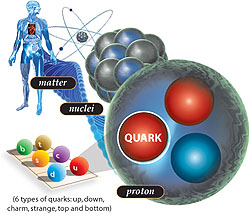Research
My current research is into the theory of the strong nuclear force, under the supervision of Prof. Christine Davies. The strong force is one of the four fundamental forces, and the theory that describes it is known as Quantum Chromodynamics, or QCD for short.
QCD describes how the fundamental constituents of matter, quarks and gluons, bind together to form more familiar particles such as protons and neutrons, which in turn bind together to form atomic nuclei, which bind together (with electrons) to form us. The binding of the quarks and gluons at the scales which we want to investigate is so strong that we cannot use the same methods we use to solve theories of the other forces (particularly the electromagnetic force, whose theory is called Quantum Electrodynamics, or QED for short).
 Image courtesy of the UKQCD collaboration.
Image courtesy of the UKQCD collaboration.
Instead we must solve the theory directly (the technical way of describing this is nonperturbatively), and this is no mean feat! Solving the theory can essentially be boiled down to solving integrals (thanks to Richard Feynman's path integral formulation of quantum field theory), but many of these integrals are impossible to do analytically - meaning that it's not mathematically possible to sit down with a pencil and paper and manipulate the mathematical symbols to get the answer. We must evaluate them numerically, which is an entirely impractical thing to do by hand. Instead, we make use of supercomputers to perform the calculations.
This requires a little bit of modification of the theory - the kind of integrals we are dealing with are defined over all time and space, and that means an infinite number of points. Clearly such a thing cannot be directly computed with a finite computer, so we discretise the integrals, meaning that we make changes to them so that they are only defined at a finite number of points, which can then be solved on a computer by inverting very large matrices. There are still a number of details to sort out from here (where, now, are our quarks, for example?), but this general method is called Lattice Gauge Theory, and was first implemented usefully by the great Ken Wilson in 1974.
Our research group has a page about Lattice QCD if you wish to explore it further!
I am also a STEM Ambassador, and am happy to answer any questions about my research that I possibly can! My contact details are all below.
I previously assisted with some research into quantum gravity via dynamical triangulations under the supervision of Dr. Jack Laiho, and you can also read more about this if you wish.
You can view and read the papers on which I am an author on the arXiv.
In June 2014 I contributed to the 32nd International Symposium on Lattice Field Theory at Columbia University in the City of New York. I gave a talk on lattice spectroscopy of the charmonium system and also wrote an accompanying proceedings article.
In February 2015, a paper I contributed to was selected as editors' suggestion in Physical Review D.


